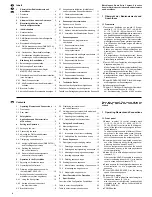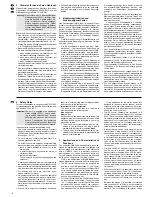
mal 120 Schritten bei denen die Überblendzeit
für alle Schritte gleich ist und bei der Wiedergabe
mit dem Regler C.F. TIME eingestellt wird.
– Die Sequenzen können manuell oder automa-
tisch, vorwärts oder rückwärts ablaufen. Der auto-
matische Ablauf kann zeit- oder musikgesteuert
erfolgen. Ein manuelles Eingreifen (z. B. zur Rich-
tungsänderung) ist während des Ablaufs möglich.
4
Inbetriebnahme
4.1 Gerät aufstellen
Das Lichtsteuerpult DMX-1440 ist für die Montage in
ein Rack (482 mm/19") vorgesehen. Hierzu werden
4 Höheneinheiten benötigt (1 HE = 44,45 mm). Es
lässt sich aber auch als freistehendes Tischgerät
verwenden.
4.2 Geräte anschließen
Vor dem Anschließen von Geräten bzw. Ändern be-
stehender Anschlüsse das Lichtsteuerpult und alle
angeschlossenen Lichteffektgeräte ausschalten.
1) Den DMX-Ausgang des Steuerpults mit dem
DMX-Eingang des ersten Lichteffektgerätes ver-
binden. Je nach Buchse am Lichteffektgerät die
3-polige oder die 5-polige XLR-Buchse DMX
OUT (31) verwenden. (Die XLR-Buchsen besitzen
eine Verriegelung. Zum Herausziehen eines
Steckers den PUSH-Hebel drücken.)
Zum Anschluss sollten spezielle Kabel für
hohen Datenfluss verwendet werden. Normale
Mikrofonkabel sind nur bei einer Gesamtkabel-
länge bis 100 m zu empfehlen. Die besten Über-
tragungsergebnisse werden mit einem abge-
schirmten Mikrofonkabel von 2 x 0,25 mm
2
oder
einem speziellen Datenübertragungskabel er-
reicht. Bei Leitungslängen ab 150 m wird das
Zwischenschalten eines DMX-Aufholverstärkers
empfohlen (z. B. SR-103DMX oder SR-105DMX
von „img Stage Line“).
2) Den DMX-Ausgang des ersten Lichteffektgerätes
mit dem DMX-Eingang des nächsten Lichteffekt-
gerätes verbinden. Dessen Ausgang wieder mit
dem Eingang des nachfolgenden Gerätes verbin-
den usw., bis alle Lichteffektgeräte in einer Kette
angeschlossen sind (siehe auch Abb. 3).
3) Den DMX-Ausgang des letzten Lichteffektgerätes
der Kette mit einem 120-
Ω
-Widerstand (0,25 W)
abschließen: An die Pins 2 und 3 eines XLR-
Steckers den Widerstand anlöten und den Ste-
cker in den DMX-Ausgang stecken.
4) Zum musikgesteuerten Ablauf einer Szenense-
quenz (Kap. 7.2) lässt sich ein Audiogerät mit
Line-Ausgang (CD-Spieler, Tape-Deck, Mischpult
etc.) an die Buchse AUDIO IN (32) anschließen.
Beim Anschluss an die Buchse wird das interne
Mikrofon (4) abgeschaltet.
5) Zuletzt den Netzstecker des Anschlusskabels
(30) in eine Steckdose (230 V~/50 Hz) stecken.
4.3 DMX-Startadressen der Lichteffektgeräte
einstellen
Die angeschlossenen Lichteffektgeräte müssen vor
dem Einschalten der gesamten Beleuchtungsan-
lage auf die 144 verfügbaren DMX-Adressen aufge-
teilt werden. Dies kann nicht nach einem vorgege-
benen Schema erfolgen, weil die Lichteffektgeräte
je nach Typ eine unterschiedliche Anzahl von DMX-
Kanälen belegen (siehe auch Abb. 7 auf Seite 19).
Jedes Lichteffektgerät muss auf eine Startadresse
eingestellt werden, d. h. auf die Adresse, mit der die
erste Funktion gesteuert wird, z. B. Adresse 19 zum
Schwenken bei einem Scanner. Belegt der Scanner
drei weitere Kanäle, z. B. zum Neigen, für Farb-
wechsel und Gobo-Wechsel, sind dann auch die fol-
genden Adressen 20, 21 und 22 automatisch zuge-
ordnet. Wenn nur identische Geräte synchron
gesteuert werden sollen, können diese die gleiche
Startadresse erhalten, andernfalls muss jedes Gerät
eine freie eigene Adresse bekommen.
Die Anzahl der benötigten DMX-Kanäle, deren
Funktionen und das Einstellen der DMX-Start-
adresse kann in der jeweiligen Bedienungsanleitung
des Lichteffektgerätes nachgelesen werden.
4.4 Steuerkanäle konfigurieren
Um einen Überblick der vielseitigen Konfigurations-
möglichkeiten zu bekommen, ist auf den Seiten 18
und 19 eine Übersicht aufgestellt. Diese sollte vor
dem Beginn der Konfigurierung beachtet werden,
um alle Möglichkeiten optimal zu nutzen.
1) Das Steuerpult mit dem Schalter POWER (8) ein-
schalten. Das Display zeigt kurz „img Stage Line
DMX-1440“ und die Nummer der Software-Ver-
sion. Danach erscheint in der ersten Zeile „Bk01
01/01“. Aus der Speicherbank 01 ist die Szene 01
aufgerufen (siehe Kap. 6).
2) Das Konfigurationsmenü mit der Taste ESC/
SETUP (21) aufrufen. Dies kann jedoch nicht
beim Ablauf oder Programmierung einer Szenen-
sequenz erfolgen. Die Menüstruktur ist in der
Abb. 4 dargestellt.
3) Das Display zeigt „Output Options? Y/N“.
a) Um die DMX-Adressen zuzuordnen (Kap.
4.4.1), die Zifferntaste 12/YES (2) drücken
(Anzeige „DMX Patch“) oder
b) um die Optionen der Steuerkanäle festzule-
gen (Kap. 4.4.2), die Taste 11/NO (2) drücken
(Anzeige „Control Options? Y/N“).
Entweder zum Bestätigen die Taste 12/YES
drücken oder um zur Zurücksetzfunktion zu
gelangen (Kap. 4.4.3), die Taste 11/NO.
4) Mit der Taste ESC/SETUP kann jeweils das Kon-
figurationsmenü verlassen werden.
calculated by the controller can be switched off
separately for each control channel.
– The 240 memorized scenes can be combined in
60 sequences. There are 2 sequence types: se-
quences for which an individual crossfading time is
programmed for each of the maximum of 60 steps
and sequences with the maximum of 120 steps
with the same crossfading time for all steps. In this
case, the crossfading time is adjusted with the
control C.F. TIME during the reproduction.
– The sequences can run manually or automati-
cally, forward or backward. The automatic run
can be made time-controlled or music-controlled.
During the run, manual intervention is possible
(e. g. for change of direction).
4
Setting into Operation
4.1 Setting up the unit
The controller DMX-1440 is provided for mounting
into a rack (482 mm/19"). For this purpose 4 rack
spaces are required (1 rack space = 44.45 mm). How-
ever, it is also possible to use it as a table-top unit.
4.2 Connecting the units
Prior to connecting units or changing existing con-
nections switch off the controller and all connected
light effect units.
1) Connect the DMX output of the controller to the
DMX input of the first light effect unit. Depending
on the jack of the light effect unit, use the 3-pole
or the 5-pole XLR jack DMX OUT (31). (The XLR
jacks have a latching. To remove a plug, press
the PUSH lever.)
For the connection, special cables for high
data flow should be used. The use of standard
microphone cables can only be recommended for
a total cable length of up to 100 m. The best
transmission results are obtained with a screened
microphone cable of 2 x 0.25 mm
2
or a special
data transmission cable. For cable lengths ex-
ceeding 150 m it is recommended to insert a
DMX level matching amplifier (e. g. SR-103DMX
or SR-105DMX from “img Stage Line”).
2) Connect the DMX output of the first light effect
unit to the DMX input of the next light effect unit.
Connect its output to the input of the subsequent
unit etc. until all light effect units are connected in
one row (also see fig. 3).
3) Terminate the DMX output of the last light effect
unit in the row with a 120
Ω
resistor (0.25 W): Sol-
der the resistor to the pins 2 and 3 of an XLR plug
and connect the plug to the DMX output.
4) For music-controlled run of a scene sequence
(chapter 7.2) it is possible to connect an audio
unit with line output (CD player, tape deck, mixer,
etc.) to the jack AUDIO IN (32). When connecting
the audio unit to the jack, the internal microphone
(4) is switched off.
5) Finally connect the mains plug of the cable (30)
to a mains socket (230 V~/50 Hz).
4.3 Adjusting the DMX start addresses of the
light effect units
Prior to switching on the complete lighting system,
the connected light effect units have to be split to the
144 available DMX addresses. This cannot be made
according to a given scheme because the light effect
units, depending on the type, reserve a different
number of DMX channels (also see fig. 7 on page
19). Each light effect unit must be adjusted to a start
address, e. g. to the address by which the first func-
tion is controlled, e. g. address 19 for panning a
scanner. If the scanner reserves three further chan-
nels, e. g. for tilting, change of colour, and change of
gobo, the subsequent addresses 20, 21, and 22 are
automatically assigned. For synchronous control of
identical units only, they can receive the same start
address, otherwise each unit must receive a blank,
individual address.
The number of the required DMX channels, their
functions, and the adjustment of the DMX start
address can be taken from the respective operating
manual of the light effect unit.
4.4 Configuring control channels
To get an overview of the various possibilities of con-
figuration, information is given on pages 18 and 19.
This should be noted prior to starting the configura-
tion to use all possibilities in an optimum way.
1) Switch on the controller with the switch POWER
(8). The display shortly indicates “img Stage Line
DMX-1440” and the number of the software ver-
sion. Then “Bk01 01/01” is displayed in the first
line. The scene 01 is called from the memory
bank 01 (see chapter 6).
2) Call the configuration menu with the button ESC/
SETUP (21). However, this cannot be made
when a scene sequence is run or programmed.
The menu structure is shown in fig. 4.
3) The display shows “Output Options? Y/N”.
a) To assign the DMX addresses (chapter 4.4.1),
press the numerical key 12/YES (2) [display
“DMX Patch”] or
b) to define the options of the control channels
(chapter 4.4.2), press the button 11/NO (2)
[display “Control Options? Y/N”].
Either press the button 12/YES to confirm or
press the button 11/NO to go to the reset func-
tion (chapter 4.4.3).
4) With the button ESC/SETUP it is possible to exit
the configuration menu in each case.
7
Output Options?
ESC /
SETUP
NO
YES
Control Options?
NO
YES
Reset All Opt’s?
NO
YES
Bk 01/01
Sure ? ? ?
NO
YES
Control Ch:
0
1
Master Depend:
Y
DMX Patch Ch:
0
01
Crossfade:
Y
Blackout:
Y
Full/Flash:
Y
ESC /
SETUP
or
ESC /
SETUP
ESC /
SETUP
Ctrl Ch:
0
1 Inv:N
Ctrl Ch:01 Inv:
N
ESC /
SETUP
or
ESC /
SETUP
ESC /
SETUP
ESC /
SETUP
Fig. 4
Menüstruktur / Menu structure
D
A
CH








































